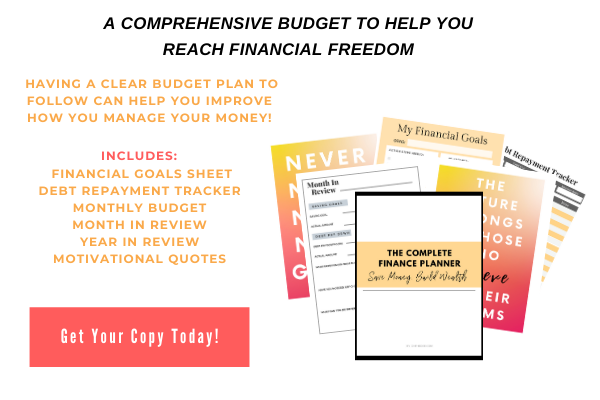How To Budget The Easy Way
Rent.
Student Loans.
Car Payments.
The list of responsibilities don’t change. Yet somehow you always end up with more days than money left each month.
How then does one break the paycheck to paycheck cycle? How do you actually reach financial freedom?
By making a budget.
Some people would rather have their eyes clawed out than to make a budget. Trust me. I was once one of those people.
However, after years of living the paycheck to paycheck cycle, I decided to try my hand at budgeting. It changed my life.
If you are tired of wondering where the f*ck your money went each month, I hear you.
Reaching financial freedom and getting rid of debt doesn’t have to be complicated. The first step to getting to your end goal is to take a good look at your current situation and map out a budget.
1) Take A Look At Your Spending

The first thing to do when making a budget is to take an honest look at your finances. You cannot know where you are going if you do not know where you have been. The easiest way to get started is by monitoring your finances for a month.
Those $30 spent last week on Taco Tuesday?
Write that down.
That $17 Target run for Oreos and face wash?
Write that down.
Tracking your spending (i.e. looking at your bank statements, Venmo account and credit card transactions) allows you to get a better sense of what it is you are spending your money on and how you can improve.
What did you spend your money on and where did you spend it? Answering this question is the first and most important step towards making a budget that works.
2) What Is Your Total Income For The Month

The second step for making a budget that works? Determine how much money you pull in every month!
For example, if you work in Corporate America, calculate how much you make from your W-2 job.
Also add in any additional income you may have coming in from a side hustle such as an Etsy Shop or tutoring gig.
If you do freelance work, average out how much you make throughout the year so that you have your “monthly income rate”.
Done calculating your total income? Good! This number is your max limit.
I will repeat that again. This is your max limit. Spending more than you earn is a recipe for disaster and makes for a crap pie. Who likes crap pies? Nobody.
The overall aim is to spend under this number. The larger you can grow the gap between your income and your spending, the better your overall financial picture will be.

3) Create Budget Categories and Determine What Is Really Essential

For the most part, after you have tracked your finances for a month or so, you will start to notice some patterns.
Do you tend to overspend on groceries, eating out or both? Create some categories that makes sense for your life.
Most importantly, record your spending using one of the many popular budgeting apps (Personal Capital, YNAB, Every Budget, Mint), Excel or with pen and paper if that is your style.
Budget Category Examples:
– Rent
– Phone
– Transportation
– Gas
– Utilities (Lights, Water, Gas, Etc.)
– Insurance (Care and Health Premiums)
– Subscriptions (Hulu, Netflix, Spotify, etc.)
– Groceries
– Eating/Going Out
– Pet Food
– Clothes
– Gym/Health Club Membership
Some of these categories are essential and leave little room for budget modifications. However, you might find that you have some wiggle room with categories such as ‘Eating Out’ or ‘Clothes’. Make the cuts you need that fit into your budget plan.
If you are not sure how much to cut a category by, start by reducing what you normally spend by ten percent.
For example, if you normally spend $300 on food, reduce that by 10% and try to stick to $270 this month.
If you find that this reduction works for your budget, in a few months try to see if you can cut your spending by another 10%.
Making a budget that works is all about tracking your expenses with intention. Keep tweaking until you get your budget categories down to a number that feels right for you and your wallet.
Related Budget + Goal Setting Articles:
4) Set A Savings Goal

Now that you know your income and your monthly expenses, the next step towards making an effective budget is to set a savings goal. It is important to always pay yourself first.
For instance, a solid goal for beginners who are just starting to make a budget is to aim to put away 10-15% of your income. The best way to get started with this goal is to automate your savings.
Automating your savings is the easiest way to make sure you pay yourself first. Decide on a percentage/fixed amount and consistently put that money away.
You’ve Got This
There you have it. Four painless steps to making a budget that works. Break out your pen and paper or perhaps your mobile app and get started on crafting that dream budget today.
It is never too late to create a positive financial picture.
Most importantly, your future self will thank you.
